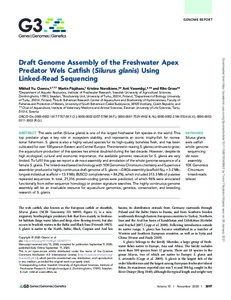Draft Genome Assembly of the Freshwater Apex Predator Wels Catfish (Silurus glanis) Using Linked-Read Sequencing
Mikhail Yu. Ozerov; Martin Flajšhans; Kristina Noreikiene; Anti Vasemägi; Riho Gross
https://urn.fi/URN:NBN:fi-fe2021042826332
Tiivistelmä
The wels catfish (Silurus glanis) is one of the largest
freshwater fish species in the world. This top predator plays a key role
in ecosystem stability, and represents an iconic trophy-fish for
recreational fishermen. S. glanis is also a highly valued
species for its high-quality boneless flesh, and has been cultivated for
over 100 years in Eastern and Central Europe. The interest in rearing S. glanis
continues to grow; the aquaculture production of this species has
almost doubled during the last decade. However, despite its high
ecological, cultural and economic importance, the available genomic
resources for S. glanis are very limited. To fulfill this gap we report a de novo assembly and annotation of the whole genome sequence of a female S. glanis.
The linked-read based technology with 10X Genomics Chromium chemistry
and Supernova assembler produced a highly continuous draft genome of S. glanis: ∼0.8Gb assembly (scaffold N50
= 3.2 Mb; longest individual scaffold = 13.9 Mb; BUSCO completeness =
84.2%), which included 313.3 Mb of putative repeated sequences. In
total, 21,316 protein-coding genes were predicted, of which 96% were
annotated functionally from either sequence homology or protein
signature searches. The highly continuous genome assembly will be an
invaluable resource for aquaculture genomics, genetics, conservation,
and breeding research of S. glanis.
Kokoelmat
- Rinnakkaistallenteet [27094]
